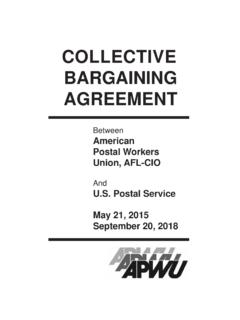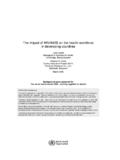Transcription of COUNTING REGISTERED APPRENTICESHIP COMPLETIONS
1 , these goals cannot be met by simply helping high school students to receive a four-year college degree. Between 2014-2024 nearly half of job openings across the country are middle skill positions that require training beyond high school, but not a four-year In order to train enough workers to meet anticipated middle-skill demand, states must pass equitable policies that help a variety of residents, particularly those with barriers to employment, receive training for in-demand careers. Training for middle-skill positions includes certificates resulting from the completion of a REGISTERED APPRENTICESHIP program. REGISTERED apprenticeships allow students to earn while they learn, by combining on-the-job training with job-related academic instruction. These programs must meet certain national standards, and the resulting certificates are nationally recognized as certifying a particular set of skills in an occupation.
2 In 2018, Congress appropriated $145 million to expand REGISTERED apprenticeships. Since 2017, the United States Department of Labor (DOL) has allocated over $100 million to thirty-six states to help them expand innovative APPRENTICESHIP Considering the significant federal investment in apprenticeships, states should take care to effectively align how they are spending this funding with their broader workforce and education goals. One way to do this is to collect data that allows them to count REGISTERED APPRENTICESHIP certificates within their postsecondary attainment goals, thereby showing how REGISTERED apprenticeships can help narrow the skills gap. COUNTING REGISTERED APPRENTICESHIP COMPLETIONS States are facing a skills gap, whereby not enough workers are adequately trained for available jobs. In order to meet this demand, many states are establishing statewide postsecondary attainment goals for the number of people with postsecondary credentials.
3 Achieving these goals can help states ensure they have a well-trained workforce and can improve living standards for residents. BY JENNA LEVENTOFF2 REGISTERED apprenticeships have valueRegistered apprenticeships benefit workers, employers, and the state s economy. Because apprenticeships are paid employment, they can help upskill workers while allowing for broader participation amongst non-traditional students and people with barriers to employment, who may not have the financial resources to stop working and pay tuition while they train for a new career. Improving postsecondary attainment for non-traditional students and those with barriers to employ-ment is key for meeting state attainment goals because there are simply not enough traditional first-time full-time students to meet the goals and fill employer demand. By completing a REGISTERED APPRENTICESHIP , workers can attain a recognized credential and have strong employment outcomes upon completion.
4 According to DOL, 90 percent of APPRENTICESHIP completers are retained by the company they apprenticed with, and apprentices have an average starting wage of more than $60,000 per Over the course of their careers, regis-tered APPRENTICESHIP completers earn an average of $240,037 more than their peers who did not participate in a REGISTERED APPRENTICESHIP APPRENTICESHIP programs are created by industry looking to hire skilled workers, they are naturally aligned with in-demand careers, and tailored to the needs of par-ticular employers. Apprenticeships have a strong return on investment for the employers who invest in them. According to a Department of Commerce study by Case Western Reserve University, Siemens USA had over a 50 percent rate of return on its machinist APPRENTICESHIP program, compared to hiring off the According to a report cited by DOL, for every dollar invested in APPRENTICESHIP training, employ-ers receive an average benefit of $ There is a clear economic benefit for states as well.
5 In addi-tion to narrowing their middle skills gap, states can save on the costs of programs such as unemployment insurance, Supplemental Nutrition Assistance Program, and Temporary Assistance for Needy Families when recipients of benefits under those programs have access to training that leads to well-paying employment. According to Mathematica Policy Research, states can earn an average social benefit, (defined as the sum of increased employee productivity and reduced administrative costs of state programs) of $124,057 over the career of an State postsecondary attainment goals should include reg-istered apprenticeships Because REGISTERED apprenticeships have a clear benefit to workers, employers, and a state s economy, states should promote policies that encourage their achievement. One way states can do this is by explicitly including REGISTERED apprenticeships within their postsecondary attainment goals.
6 This signals to the public that REGISTERED apprentice-ships are a valid pathway to a strong career. It also pro-vides incentive to state policymakers to pass policies that make REGISTERED APPRENTICESHIP programs more prevalent, which could help states narrow their skills gaps. However, according to an unpublished 2017-18 survey conducted by workforce Data Quality Campaign (WDQC), only twenty-one states reported including REGISTERED APPRENTICESHIP certifi-cates within their postsecondary attainment REGISTERED APPRENTICESHIP COMPLETIONS3To understand progress towards meeting attainment goals, states must collect data about REGISTERED apprenticeshipsIn order for states to successfully measure progress towards a postsecondary attainment goal that includes REGISTERED apprenticeships, a state must collect individual-level data about REGISTERED apprenticeships. This enables the state to know which residents have enrolled in REGISTERED apprentice-ship programs, which industries those apprenticeships are in, and the demographic characteristics of those who completed their APPRENTICESHIP and earned a certificate.
7 According to WDQC s Measuring Non-Degree Credential Attainment Fifty State Scan, twenty-seven states reported having most or all data about REGISTERED APPRENTICESHIP programs within a state The rest of the states may not have an accurate method of knowing how many of their residents have enrolled in and completed REGISTERED APPRENTICESHIP programs, and how those COMPLETIONS help equitably address the skills gap. The process for collecting data about REGISTERED appren-ticeships, which usually includes data about the apprentice and the APPRENTICESHIP program, varies depending upon where a state s programs are administered. Administration of REGISTERED APPRENTICESHIP programs varies among states. About half of state REGISTERED APPRENTICESHIP programs are administered by a state agency referred to as a State APPRENTICESHIP Agency (SAA). In the rest of states, DOL s Office of APPRENTICESHIP (OA) directly registers and oversees APPRENTICESHIP programs.
8 Because APPRENTICESHIP programs are overseen in different places, there is no comprehensive repository of information about all REGISTERED APPRENTICESHIP programs in the country. DOL s data system that holds REGISTERED APPRENTICESHIP data is called the REGISTERED APPRENTICESHIP Partners Information Data System (RAPIDS) The database contains information about apprentices and REGISTERED APPRENTICESHIP programs in all states whose REGISTERED APPRENTICESHIP programs are over-seen by DOL, as well as nine state programs administered at SAAs. RAPIDS has data about apprentices such as a unique identifier, demographic information, contact information, and current enrollment status in an APPRENTICESHIP program. It also contains program information including the related instruction provider, the employer, the duration of on-the-job instruction, and the apprentice s wage In the rest of states, data about a particular state s REGISTERED APPRENTICESHIP programs is likely held within that state s SAA database.
9 SAAs usually collect similar data to that in RAPIDS , however, the specific data elements may vary slightly from state to state. There is no clear benefit to where a state s REGISTERED appren-ticeship data is housed, provided that the entity holding the data is willing to share it. This paper provides case studies about how two states that include REGISTERED APPRENTICESHIP within their postsecondary attainment goals access and share REGISTERED APPRENTICESHIP data. Iowa represents states whose programs are administered by DOL, and Washington rep-resents SAA states. Iowa and Washington deserve recognition for collecting individual-level data on APPRENTICESHIP completers, although as pointed out below, there is still more both states could do to track APPRENTICESHIP data as part of measuring educational can add APPRENTICESHIP data to their state longitu-dinal data systems (SLDS). SLDS allow states to fully utilize data they already collect by matching data from different programs and agencies across time.
10 These systems contain privacy-protected data that follow an individual s prog-ress through K-12, postsecondary education, training, the workforce , and sometimes include social service programs. Adding REGISTERED APPRENTICESHIP and other credentials data to their SLDS may make it easier for states to measure prog-ress towards their postsecondary attainment goals, because all of the data about credential attainment can be stored in one place. Moreover, adding data about REGISTERED appren-ticeships to their SLDS will help states to better understand how apprenticeships fit into their overall workforce and edu-cation training system. This can help policymakers design and fund effective programs, can help educators adjust programs based on outcomes, and can allow students to find education and training that meets their needs. When individual-level data in the SLDS includes demographic information, all of these audiences can better understand how programs are serving non-traditional students and those with barriers to employment.








